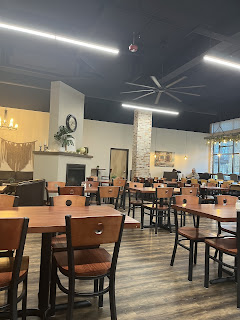The High Ground & Chávez
In a rare change of scenery, this post's coffee feature is not near Voxman. This weekend I ventured a little farther off campus and checked out the High Ground Cafe. There was plenty of seating for a Sunday morning, and I quickly received my drink. Unfortunately, my cortado was slightly over steamed (the texture was more in line with what I would expect from a cappuccino) so I would like to come back and try out something else from their menu.
This week in class I'm excited to talk about the Sonata for Four Horns by Carlos Chávez. Carlos Chávez was a Mexican conductor and composer of the 20th century (he was born June 13, 1899 in Mexico City and died there on August 2, 1978). He composed a plethora of works, including symphonies, concertos (including a trombone concerto), ballets, and chamber music. His music combines elements of Western Classical and indigenous Mexican music. For example, he uses a lot of melodic and rhythmic patterns from Mexican folk music, alongside the influence of modern composers such as Igor Stravinsky and Arnold Schoenberg. As a conductor he is best known for founding the Symphony Orchestra of Mexico in 1928 and he also was the director of the national conservatory in Mexico from 1928 to 1933 (and a bit of 1934).
Chávez wrote the Sonata for Four Horns in 1929 after being appointed to the national conservatory. It was inspired by the Mexican mural artwork and Chávez’s experience as an orchestral conductor working with section horns. Chávez also went on to write a concerto for four horns and orchestra in 1937.
The recording I will be using is from the Southwest Chamber Music’s album: Carlos Chávez: Complete Chamber Works, Vol. 2. This CD won a Grammy (which is not something we usually think of when we talk about brass ensemble music) at the 47th Grammys in 2005 for (Southwest won the previous year with another album of Chávez’s chamber music) for Best Small Ensemble Performance. Southwest Chamber music was founded in 1987 by Jeff von der Schmidt. This piece was recorded on October 27 & 28, 2003 at the Colburn School in Los Angeles. The performers are James Atkinson (First Horn), Nathan Campbell (Second Horn), Andrew Pelletier (Third Horn), and Warren Gref (Fourth Horn).
The first movement, Allegro, resembles a modern sonata form (with a recapitulation of the two primary themes). This movement highlights what one could think of as unconventional voicing of the horn parts. For example, the third horn is often lower than second horn, which is the opposite of what many of us would expect based off of orchestral horn writing, as well as other popular horn quartets (in which the third horn is treated as a higher part than second horn). We can see the influence of orchestral section writing in this movement as the composer often writes the four voices as one force, or will pair off the horns. I enjoy Chávez's use of a wide range of articulations and find that it gives the movement a very dynamic character. Lastly, I think this movement highlights the harmonic writing of Chávez's works. They are chromatic but still approachable & audience friendly.





Comments
Post a Comment